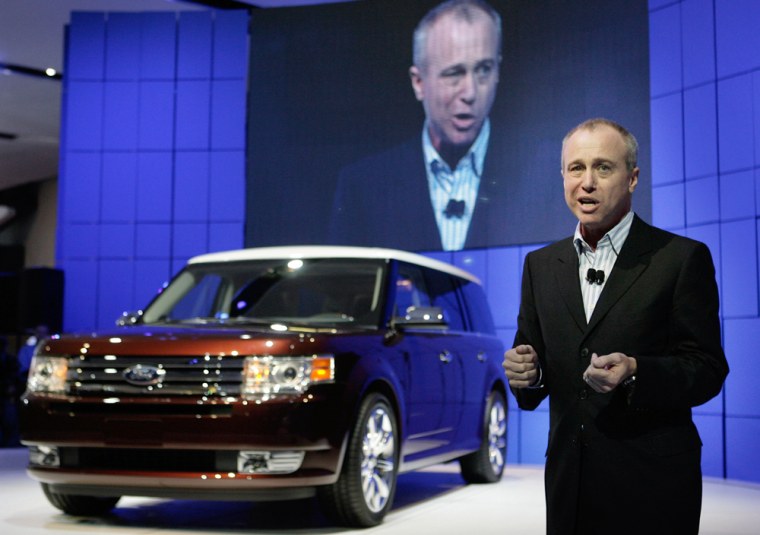When Ford’s Flex rolled onto the stage last week at the New York auto show, the reaction from the automotive journalists gathered to witness its debut was decidedly mixed. The boxy, six-passenger crossover is being positioned as Ford’s more stylish alternative to the minivan, a segment it abandoned in 2006.
To some, the Flex looked like a strange, oversized Mini Cooper, although others saw merit in its distinctively modern feel. And there was some confusion about the name, which seemed to suggest a flexible-fuel vehicle that can alternate between two fuel sources.
(In fact, the name refers to vehicle’s “flexibility” in hauling passenger and cargo, and there are no special fuel attributes other then a “capless” fueling system that saves you from forgetting to put the gas cap back on after fueling.)
At times, Ford appears overly focused on gimmicks. The Flex was the automaker’s top offering at the New York show. The automaker's other offerings included several limited-edition vehicles: the Funkmaster Flex Ford Expedition, a version of the SUV designed for hip-hop impresario Funkmaster Flex, an F-150 pickup truck redesigned by car customizer Chip Foose and the 540-horsepower “King of the Road” Shelby GT500KR Mustang, devised by racing legend Carroll Shelby.
The showing did little to impress analysts looking for serious signs of a turnaround at the struggling carmaker.
“Ford already has fancy versions of the Mustang out there, so another halo vehicle with a limited production run is nice, but it doesn’t do anything for Ford’s bottom line,” said Aaron Bragman, a Global Insight analyst. “The Flex is a much more critical vehicle for Ford — it has to sell, and it has to sell in some volume and at the appropriate price to make up for the money that Ford is not making on the Expedition and the Explorer and reduced volumes of the F-150.”
The unique-looking Flex — which joins the Edge and Taurus X in Ford’s growing lineup of crossovers — is designed to stand out in “an increasingly crowded sea of crossovers” said J Mays, Ford’s chief creative officer. Indeed, when it goes on sale next year it will include a host of “cool” features, like a refrigerator in the second row of seats, a 2,300-song juke box and a multipanel sunroof. Safety features include a rear back-up camera and electronic stability control.
Ford is hoping to capture a chunk of the automotive industry’s fastest-growing segment, taking on crossovers like the GMC Acadia and Saturn Outlook, although while you can go out and buy a GMC Acadia and a Saturn Outlook now, you’ll have to wait until mid-2008 to get your hands on the new Flex.
U.S. crossover sales rose to more than 2.2 million units last year, up from about 700,000 in 2000, according to J.D. Power and Associates' Power Information Network. Minivan sales by contrast fell under 1 million units from about 1.3 million in 2000.
Ford badly needs a blockbuster hit. Like rivals General Motors and Chrysler, Ford has been racking up heavy losses, pummeled by Asian automakers that have taken a growing share of the U.S. market. The Big Three also are saddled with billions of dollars in healthcare and pension obligations and have been hurt by a shift away from profitable but gas-guzzling SUVs and trucks.
All three automakers have announced massive layoffs, plant closures and a shake-up of their product offerings, but the outlook for Ford is bleaker than its rivals. GM, the world’s largest automaker, is starting to stem the flow of red ink, and Chrysler is likely to be sold by its German parent, DaimlerChrysler.
But Ford, which lost $12.7 billion last year, the largest loss in its 103-year history, has mortgaged factories, buildings and brands to secure a $23 billion line of credit to fund its restructuring plan and cover the losses it expects to rack up until 2009, when it hopes to turn a profit.
“This is Ford’s last shot,” said Bragman. “If they can’t turn this thing around, things are going to be difficult in the years ahead because the whole company is mortgaged. They had to get that loan because the liquidity situation was untenable. They were not turning a profit at their automotive operations. But in 2009 they have to turn a profit and start paying back some of the money they have secured. If they don’t manage to do it, it’s going to be a very difficult situation for Ford.”
Unfortunately, Ford has shown little sign it has a strong pipeline of new vehicles coming to market, analysts say.
“We are concerned that we don’t see the same activity we are seeing at other automakers in their turnarounds,” said Bragman.
“If you look at GM, they’ve done a good job of communicating their plans for the future to the industry at large, and as such they really have restored confidence in their turnaround plan. Ford should be announcing to the world the products that they plan to come up with — the products coming out in the next three to five years — because that’s what is going to restore the confidence in much of the industry that they can turn their business around.”
One positive for Ford is the elevation of the company’s chief vehicle designer, J Mays, who is responsible for shaping the design direction of Ford’s eight global brands. A criticism of Ford has been the blandness of its design, particularly of vehicles like the Ford Five Hundred, now renamed the Taurus. Mays is credited with redesign successes like the new Volkswagen Beetle and the Ford Thunderbird, and his prominence at Ford will help the company focus on producing well-styled vehicles, analysts say.
